Charles E W Bean, Diaries, AWM38 3DRL 606/259/1 - 1917 - 1927 - Part 4
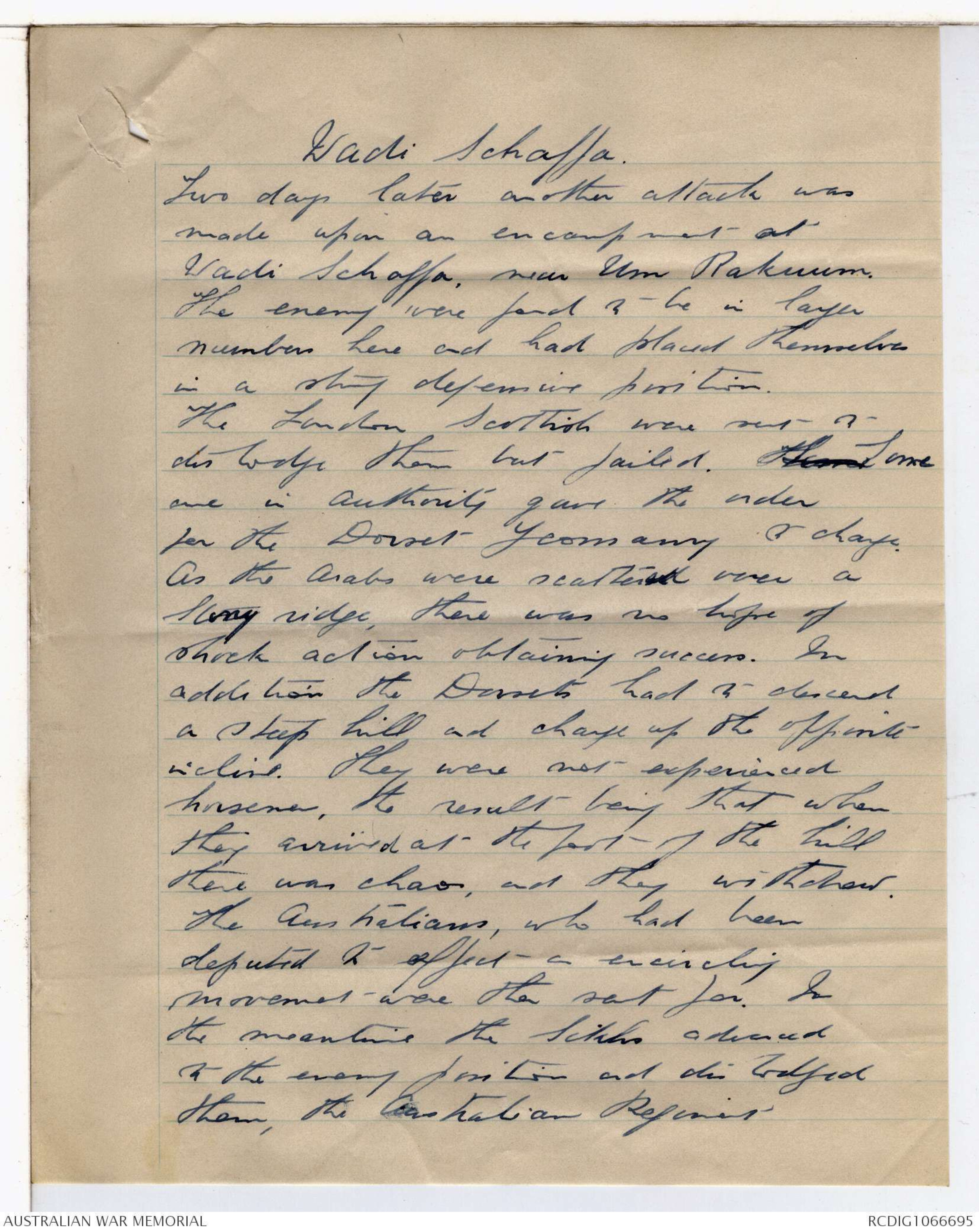


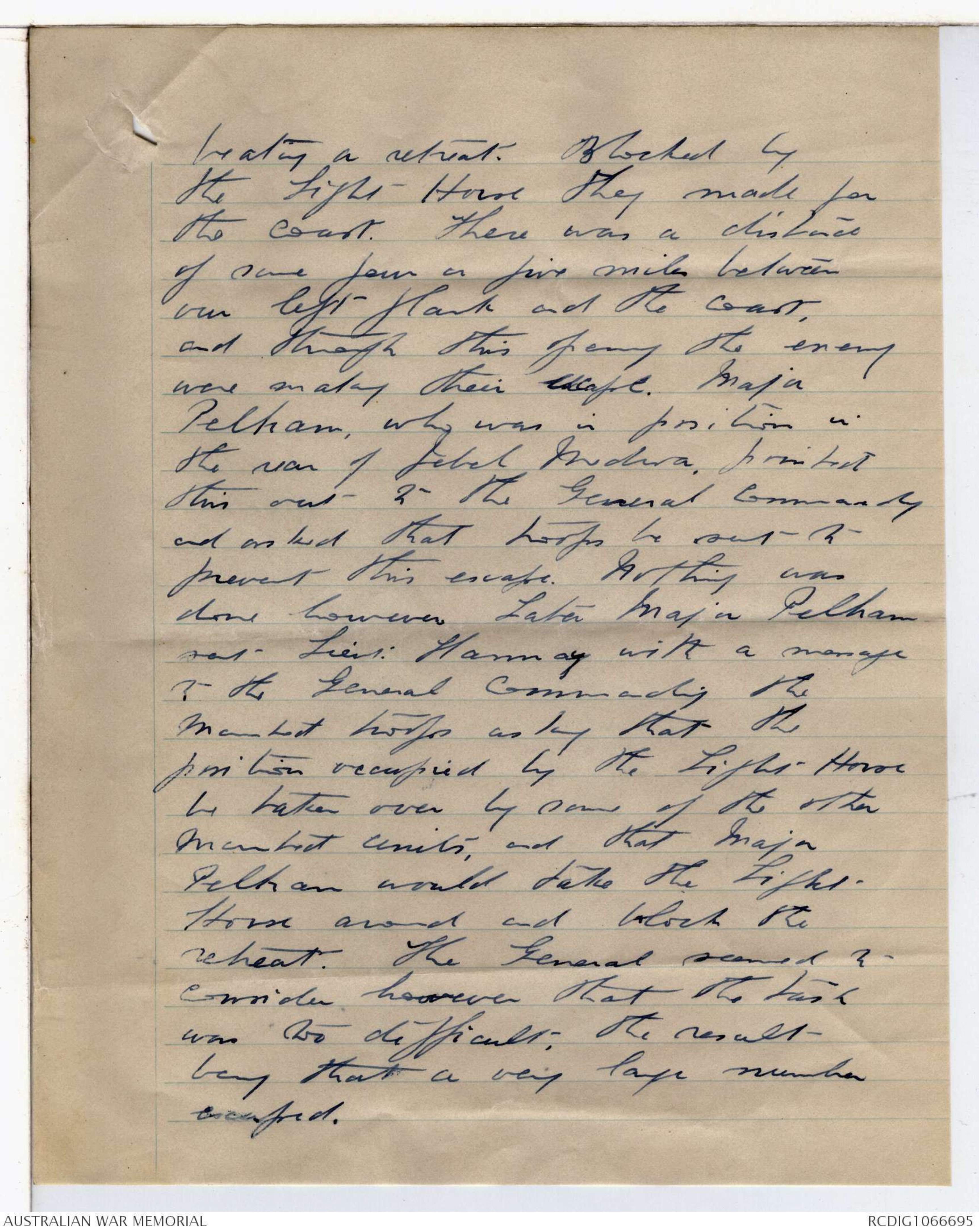
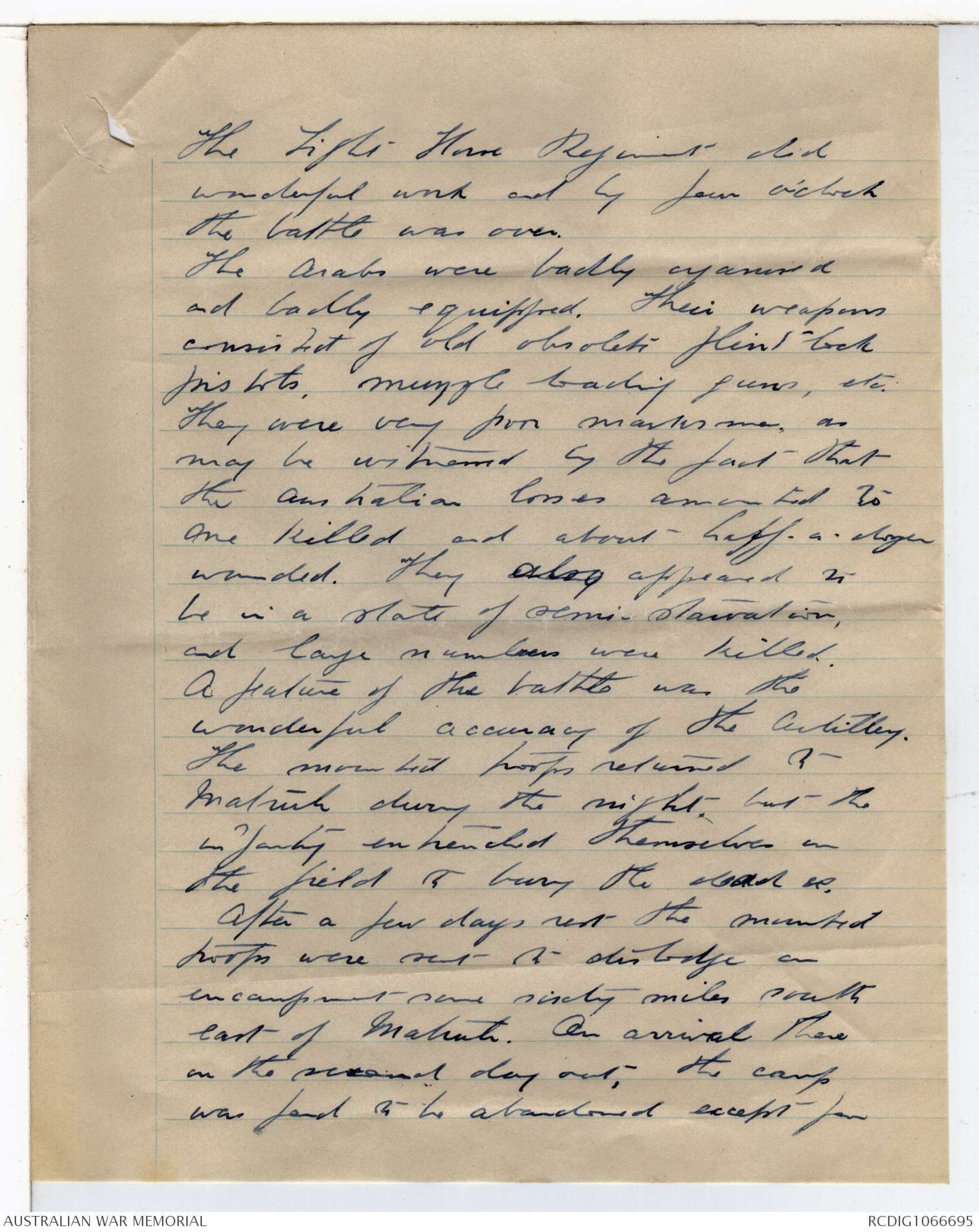
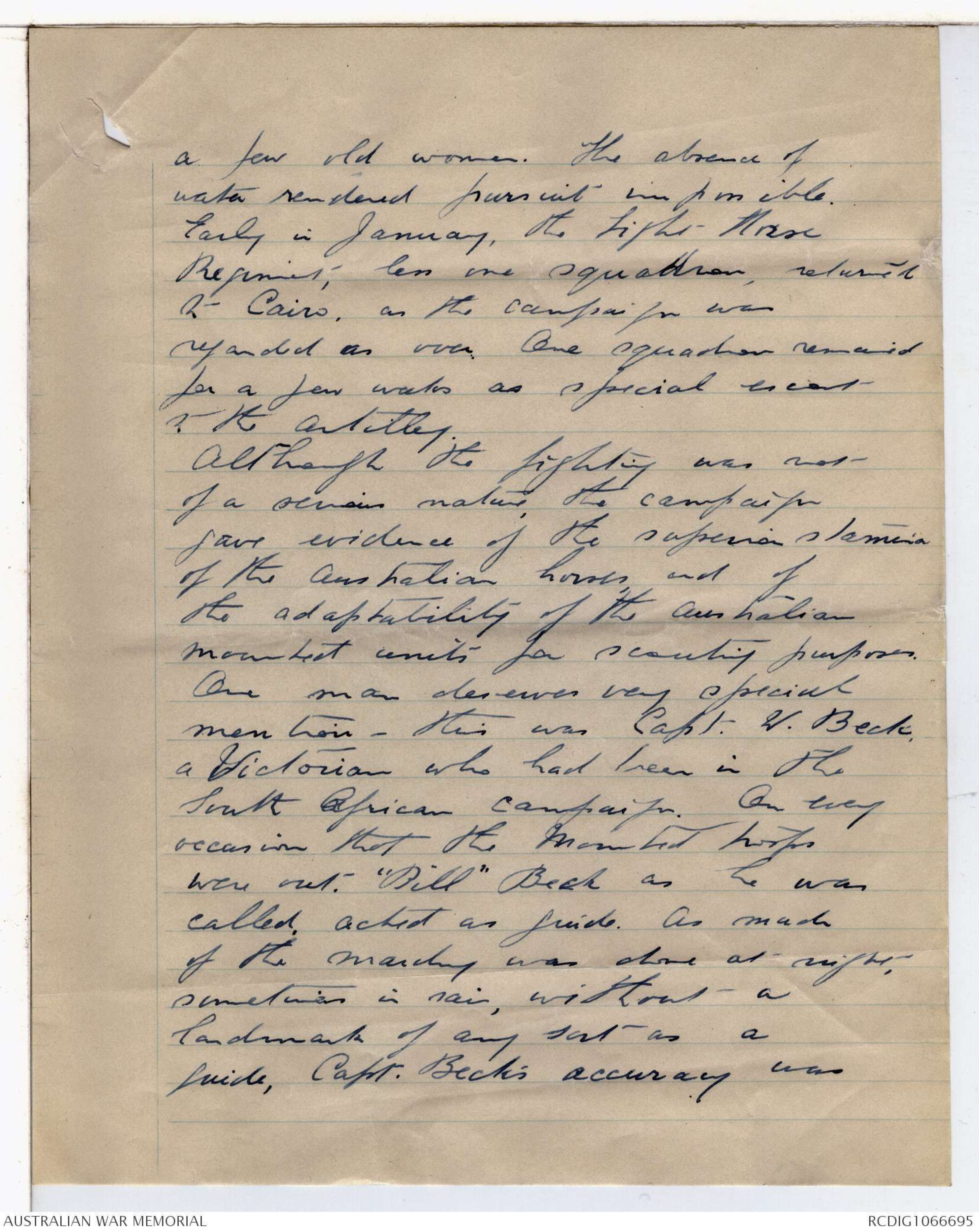
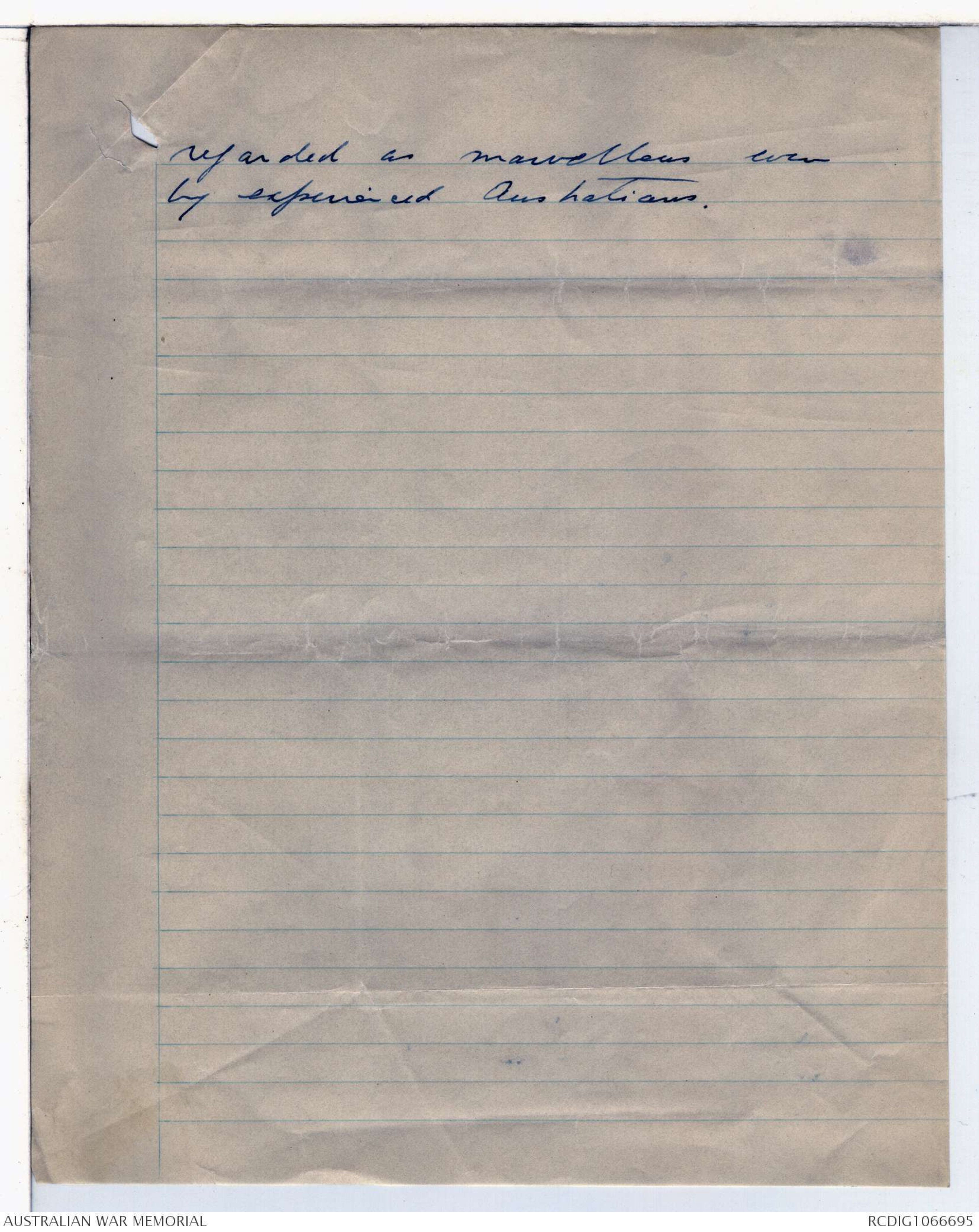

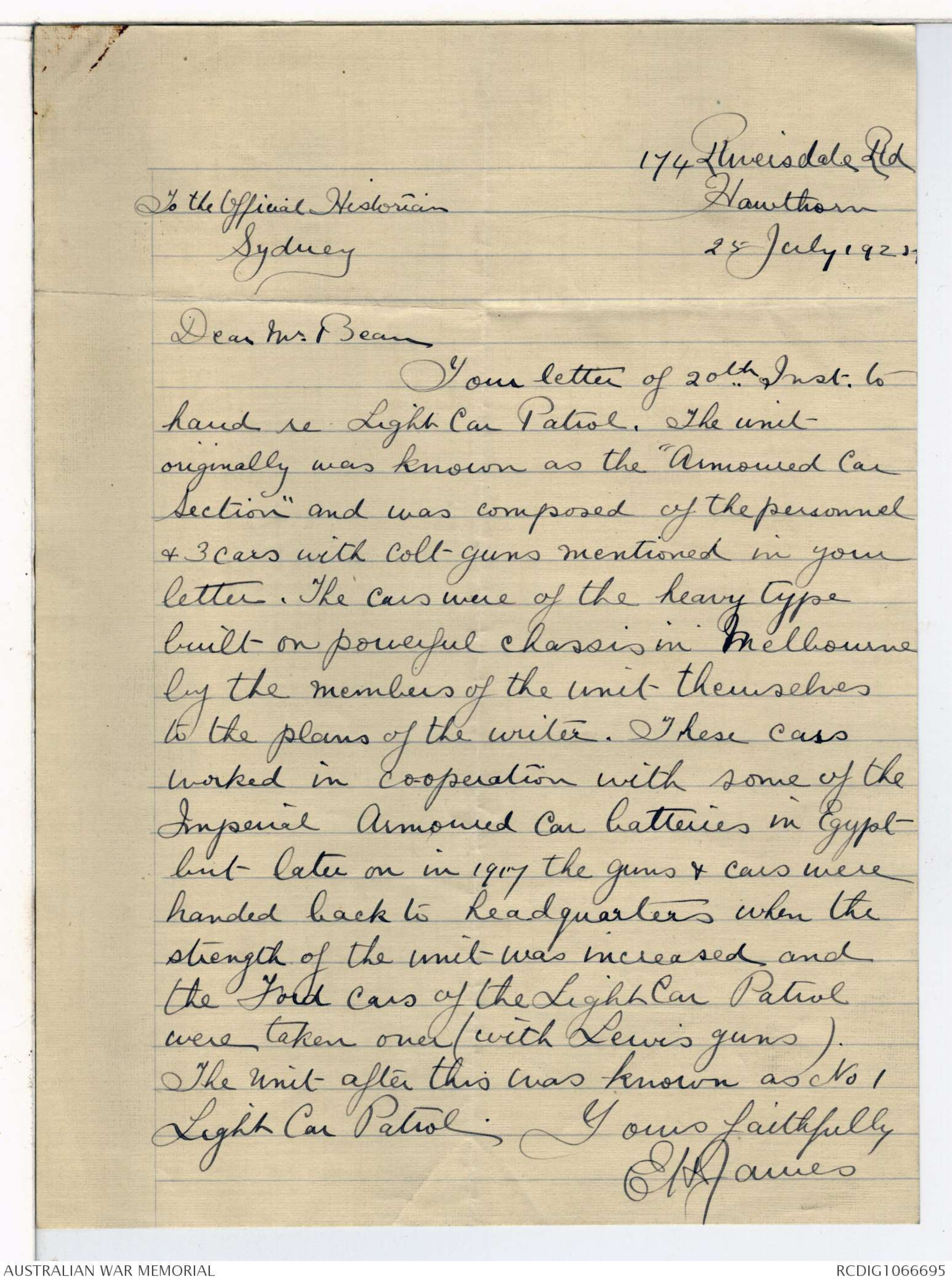
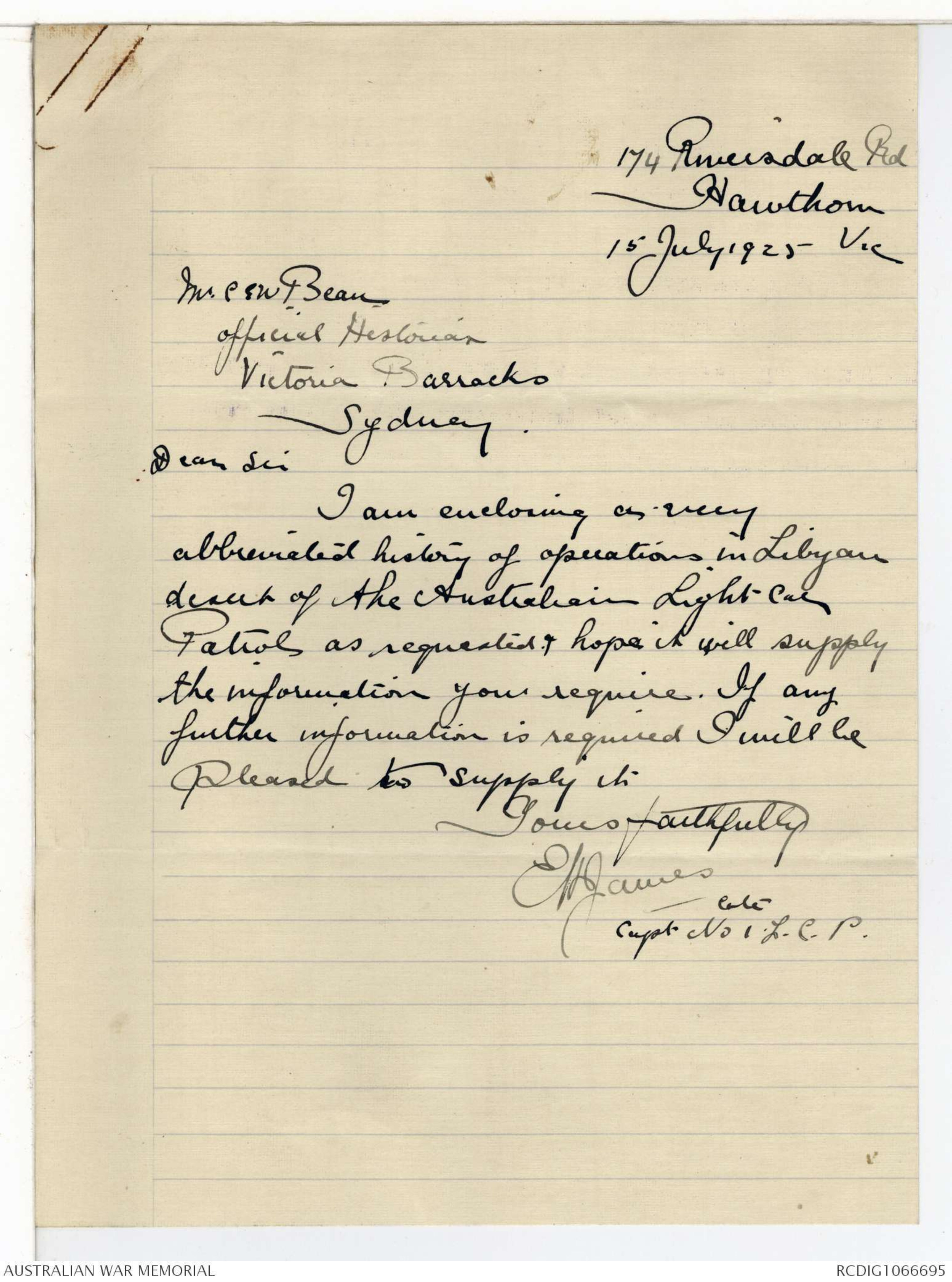
Wadi Schaffa.
Two days later another attack was
made upon an encampment at
Wadi Schaffa, near Um Rakuum.
The enemy were found to be in larger
numbers here and had placed themselves
in a strong defensive position.
The London Scottish were sent to
dislodge them but failed. Then Some
one in Authority gave the order
for the Dorset Yeomanry to charge.
As the Arabs were scattered over a
stony ridge, there was no hope of
shock action obtaining success. In
addition the Dorsets had to descend
a steep hill and charge up the opposite
incline. They were not experienced
horsemen, the result being that when
they arrived at the top of the hill
there was chaos, and they withdrew.
The Australians, who had been
deputed to effect an encircling
movement were then sent for. In
the meantime the Sikhs advanced
to the enemy position and dislodged
them, the Australian Regiment
following and thoroughly routing
them. Some importance was
attached to this engagement, but
the opposition was very weak
Jebel Medura.
Some days were now spent in
burning and destroying the villages, with
the result that the main body of
Arabs were driven into the one
camp at Jebel Medura, a
few hours march south of Mersa
Matruh. It was here that the only
serious engagement of the campaign
took place. On Christmas Day 1915.
our full force was engaged against
this position. The infantry and armoured
cars, with half a brigade of artillery
made a frontal attack. The mounted
troops with the remaining artillery
were to make a wide encircling
movement and attack from the
rear and prevent the enemy retreating
into the desert: The mounted troops
left their position at Mersa Matruh
at two o'clock on Christmas morning.
About six at a.m. the rattle
musketry on our right told us
that the infantry were in action.
Shortly afterwards, just at sunrise,
our vanguard, (a squadron of Australian
Light Horse) under Major Bisdee V.C.
came in contact with the enemy
flank patrols. At a signal the
whole of the mounted force deployed
into action at the gallop. It was
a most spectacular movement, but
the vanguard, with the assistance of
the artillery dispersed the Arabs, which
consisted only of a few badly-mounted
troops. The encircling movement was
continued. By mid day we were
in position in rear of the enemy.
The Australian Light Horse were
the Advanced Guard during the whole
day and were the only portion of
the mounted troops to be placed in to
action. The enemy held a number
of strong positions but were easily
dislodged. The infantry in the
meantime had captured Jebel
Medura and the enemy were
beating a retreat. Blocked by
the Light Horse they made for
the coast. There was a distance
of some four or five miles between
our left flank and the coast,
and through this opening the enemy
were making their escape. Major
Pelham, who was in position in
the rear of Jebel Medura, pointed
this out to the General Commandg
and asked that troops be sent to
prevent this escape. Nothing was
done however Later Major Pelham
sent Lieut. Hannay with a message
to the General Commanding the
mounted troops asking that the
position occupied by the Light Horse
be taken over by some of the other
mounted units, and that Major
Pelham would take the Light
Horse around and block the
retreat. The General seemed to
consider, however that the task
was too difficult; the result
being that a very large number
escaped.
The Light Horse Regiment did
wonderful work and by four o'clock
the battle was over.
The Arabs were badly organised
and badly equipped. Their weapons
consisted of old obsolete flint lock
pistols, muzzle loading guns, etc.
They were very poor marksmen, as
may be witnessed by the fact that
the Australian losses amounted to
one killed and about half-a-dozen
wounded. They also appeared to
be in a state of semi-starvation,
and large numbers were killed.
A feature of the battle was the
wonderful accuracy of the Artillery.
The mounted troops returned to
Matruh during the night but the
infantry entrenched themselves in
the field to bury the dead &c.
After a few days rest the mounted
troops were sent to dislodge an
encampment some sixty miles south
east of Matruh. On arrival there
on the second day out, the camp
was found to be abandoned except for
a few old women. The absence of
water rendered pursuit impossible.
Early in January, the Light Horse
Regiment, less one squadron, returned
to Cairo, as the campaign was
regarded as over. One squadron remained
for a few weeks as special escort
to the Artillery.
Although the fighting was not
of a serious nature, the campaign
gave evidence of the superior stamina
of the Australian horses and
the adaptability of the Australian
mounted units for scouting purposes.
One man deserves very special
mention - This was Capt. W. Beck
a Victorian who had been in the
South African campaign. On every
occasion that the mounted troops
were out. "Bill" Beck as he was
called, acted as guide. As much
of the marching was done at night,
sometimes in rain, without a
landmark of any sort as a
guide, Capt. Beck's accuracy was
regarded as marvellous even
by experienced Australians.
174 Riversdale Road,
HAWTHORN.
VICTORIA.
24th June, 1925.
Mr. C.E.W. Bean,
Official Historian,
Victoria Barracks.
SYDNEY.
Dear Sir.
I am in receipt of your letter of the 16th inst. in
reference to operations of Australian Light Car Patrol. In answer
to same I wish to state that the Light Car Patrol was not at
Mersa Matruh, but during the Senoussi Campaign was operating further
south chiefly around the Kharga and Dakhla oasis in the Libyian
Desert and at one time was between 500 and 600 miles inland.
Shortly after Xmas 1916 the Patrol attempted to cross
the desert to the oasis of Kufra where no Europeans have ever been
and although the attempt was unsuccessful the Australian Light
Car Patrol succeeded in penetrating further into this desert than
any other Whites have ever done. Early in 1917 the Patrol was
moved into Palestine where it took part in all the operations
after the second battle. of Gaza until long after the Armistice
finishing up further North than any other A.I.F. troops. The
No.1 L.C.P. probably fired the last shot of the war as on 12th
Jan. 1919 the Patrol engaged a force of Turkish brigands near
Aintab (about 100 miles north of Aleppo) and exterminated the lot
without any casualties themselves. It is not generally known that
the Light Car Patrol in conjunction with other armed motors
captured the stronghold of Aleppo several days before the cavalry
were on the scene. If any particulars of the operations of the
Patrol are required I can supply same, as I have pretty full notes.
Yours faithfully.
E W James
Captain Aust Light Car Patrol
174 Riversdale Road,
Hawthorn
24 July 1925
To the Official Historian
Sydney
Dear Mr. Bean
Your letter of 20th Inst to
hand re Light Car Patrol. The unit
originally was known as the "Armoured Car
Section" and was composed of the personnel
& 3 cars with Colt guns mentioned in your
letter. The cars were of the heavy type
built on powerful chassis in Melbourne
by the members of the unit themselves
to the plans of the writer. These cars
worked in cooperation with some of the
Imperial Armoured Car batteries in Egypt
but later on in 1917 the guns & cars were
handed back to headquarters when the
strength of the unit was increased and
the Ford cars of the Light Car Patrol
were taken over (with Lewis guns).
The unit after this was known as No 1
Light Car Patrol
Yours faithfully
E W James
174 Riversdale Road,
Hawthorn
Vic
15 July 1925
Mr CEW Bean
official Historian
Victoria Barracks
Sydney
Dean Sir
I am enclosing a very
abbreviated history of operations in Libyan
desert of the Australian Light Car
Patrols as requested & hope it will supply
the information you require. If any
further information is required I will be
pleased to supply it.
Yours faithfully
E W James
late
Capt No 1 L.C.P.
 Sam scott
Sam scottThis transcription item is now locked to you for editing. To release the lock either Save your changes or Cancel.
This lock will be automatically released after 60 minutes of inactivity.